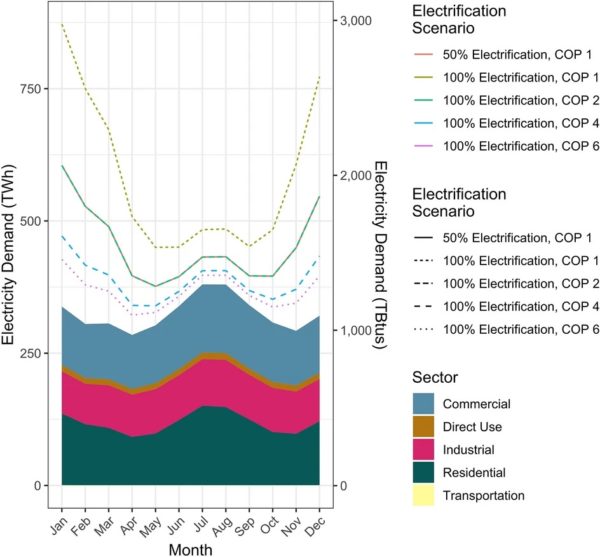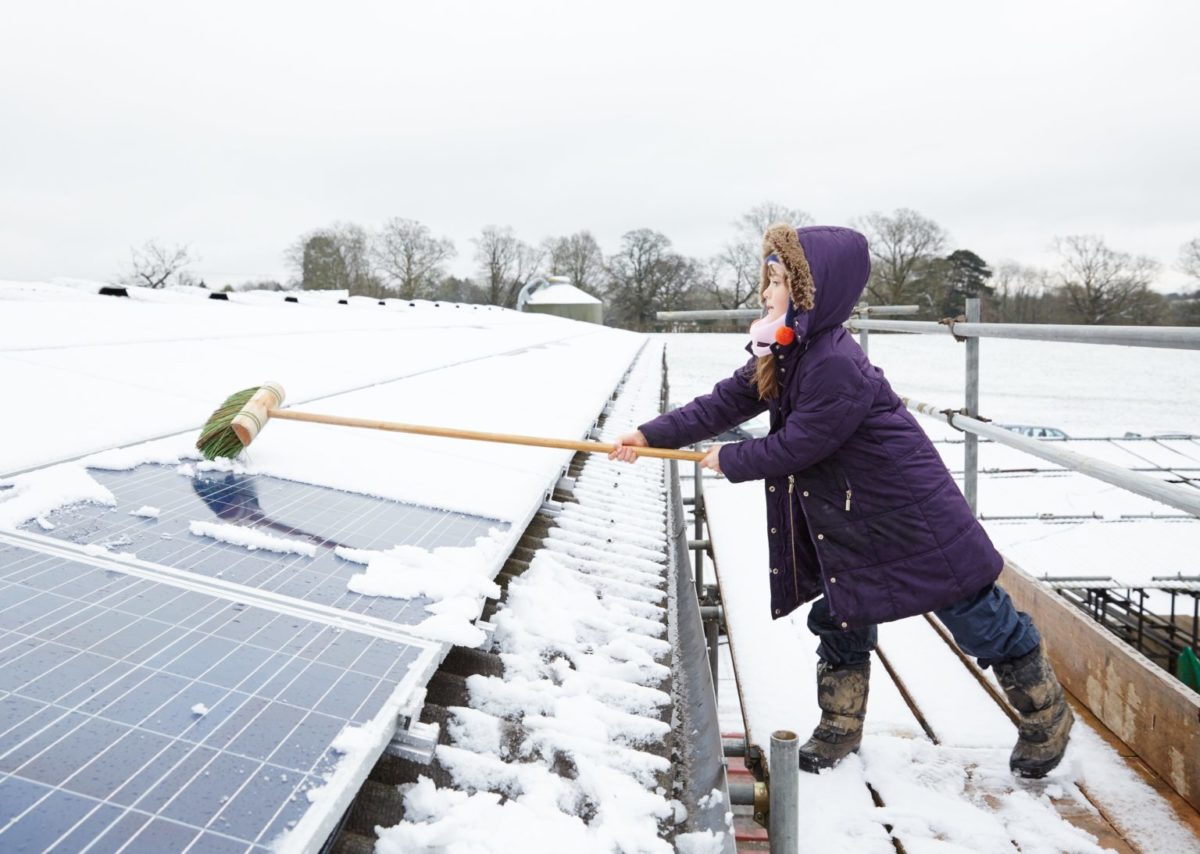From pv magazine the USA
Most building decarbonization models do not account for seasonal fluctuations in energy demand for heating or cooling, which makes it difficult to predict what switching to all-electric heating could mean for the electrical grid, especially during peaks in energy use.
A new study by researchers at Boston University School of Public Health (BUSPH), Harvard T.H. Chan School of Public Health, Oregon State University, and the nonprofit Home Energy Efficiency Team (HEET) examined these seasonal changes in energy demand, and found that monthly energy consumption varies substantially and is highest in the winter months.
The study “Inefficient Building Electrification Will Require Massive Buildout of Renewable Energy and Seasonal Energy Storage,” published in Scientific Reports, presented novel modeling of multiple building electrification scenarios and found that the surge in winter energy demand will be difficult to satisfy through current renewable sources, if buildings switch to low-efficiency electrified heating. The findings emphasize the need for buildings to install more efficient home-heating technologies, such as ground source heat pumps.
“Our research reveals the degree of fluctuation in building energy demand and the benefits of using extremely efficient heating technologies when electrifying buildings,” says Jonathan Buonocore, assistant professor of environmental health at BUSPH and study lead and corresponding author.
“Historically, this fluctuation in building energy demand has been managed largely by gas, oil, and wood, all of which can be stored throughout the year and used during the winter. Electrified buildings, and the electrical system that supports them, will have to provide this same service of providing reliable heating in winter. More efficient electric heating technologies will reduce the electrical load put on the grid and improve the ability for this heating demand to be met with non-combustion renewables.”
The study analyzed building energy data from March 2010 to February 2020, and found that total monthly average for energy consumption in the United States, based on the current use of fossil fuels, as well as future use of electricity in the winter, varies by a factor of 1.6x, with the lowest demand in May, and the highest demand in January.
The researchers modeled these seasonal fluctuations in what they call the “Falcon Curve’’, a graph of the change in monthly energy consumption (which represents the shape of a falcon). The data shows that winter heating demand drives energy consumption to its highest levels in December and January, with a secondary peak in July and August due to cooling, and the lowest levels in April, May, September, and October.

Image: Boston University School of Public Health, scientific reports, Creative Commons License CC BY 4.0
The researchers then calculated the amount of additional renewables, specifically wind and solar energy, that would need to be generated to meet this increased demand in electricity. They found that to meet winter peaks, without storage, demand response, or other tactics to manage grid load, buildings would require a 28x increase in January wind generation or a 303x increase in January solar energy. Then they calculated adding more efficient renewables, such as air source heat pumps or ground source heat pumps, and found that buildings would only require 4.5x more winter wind generation, or 36x more solar energy—thus “flattening” the Falcon Curve as less new energy demand is placed on the electrical grid.
“This work really shows that technologies on both the demand and the supply side have a strong role to play in decarbonization,” says study coauthor Parichehr Salimifard, assistant professor of college of engineering at Oregon State University.
Examples of these technologies on the energy supply side are geothermal building heating and renewable energy technologies that can provide energy at all hours, she says—such as renewables coupled with long-term storage, distributed energy resources at all scales, and geothermal electricity generation where possible.
“These can be coupled with technologies on demand side—i.e., in buildings—such as passive and active building energy efficiency measures, peak-shaving, and energy storage in buildings. These building-level technologies can both reduce the overall building energy demand by reducing both baseline and maximum energy demand as well as smooth the fluctuations in building energy demand, and consequently flatten the Falcon Curve,” said Salimifard.
“The Falcon Curve draws our attention to a key relationship between the choice of building electrification technology and the impact of building electrification on our power grid,” said study coauthor Zeyneb Magavi, co-executive director of HEET, a non-profit climate solutions incubator.
Magavi cautions that this research does not yet quantify this relationship based on measured seasonal efficiency curves for specific technologies, or for more granular time scales or regions. It also does not assess the numerous strategies and technologies that can help address the challenge–all of which must be considered in decarbonization planning.
Even so, Magavi says this research indicates that, “Using a strategic combination of heat pump technologies (air-source, ground-source, and networked), as well as long-term energy storage, will help us electrify buildings more efficiently, economically, and equitably. The Falcon curve shows us a faster path to a clean, healthy energy future.”
“Our research makes clear that, when accounting for seasonal fluctuations in energy consumption apparent in the Falcon Curve, the drive to electrify our buildings must be coupled with a commitment to energy-efficient technologies to ensure building decarbonization efforts maximize climate and health benefits,” says study senior author Joseph G. Allen, associate professor of exposure assessment science and director of the Healthy Buildings program at
One fundamental change is, even under high-efficiency building electrification, the US electrical grid will likely switch from peaking in summer to winter. The researchers concluded that for building electrification to represent “healthy decarbonization of building energy, the additional electricity demand needs to be met with non-combustion renewable energy, which under our most optimistic scenario will require increasing wind generation by 4.5×”.
Currently, the seasonal fluctuations are being met largely by a fossil energy system with long-term energy storage. In an all-electric scenario, long-term electricity storage may have a strong role in aiding renewable electricity in meeting the demand from newly electrified buildings.
This content is protected by copyright and may not be reused. If you want to cooperate with us and would like to reuse some of our content, please contact: editors@pv-magazine.com.




By submitting this form you agree to pv magazine using your data for the purposes of publishing your comment.
Your personal data will only be disclosed or otherwise transmitted to third parties for the purposes of spam filtering or if this is necessary for technical maintenance of the website. Any other transfer to third parties will not take place unless this is justified on the basis of applicable data protection regulations or if pv magazine is legally obliged to do so.
You may revoke this consent at any time with effect for the future, in which case your personal data will be deleted immediately. Otherwise, your data will be deleted if pv magazine has processed your request or the purpose of data storage is fulfilled.
Further information on data privacy can be found in our Data Protection Policy.